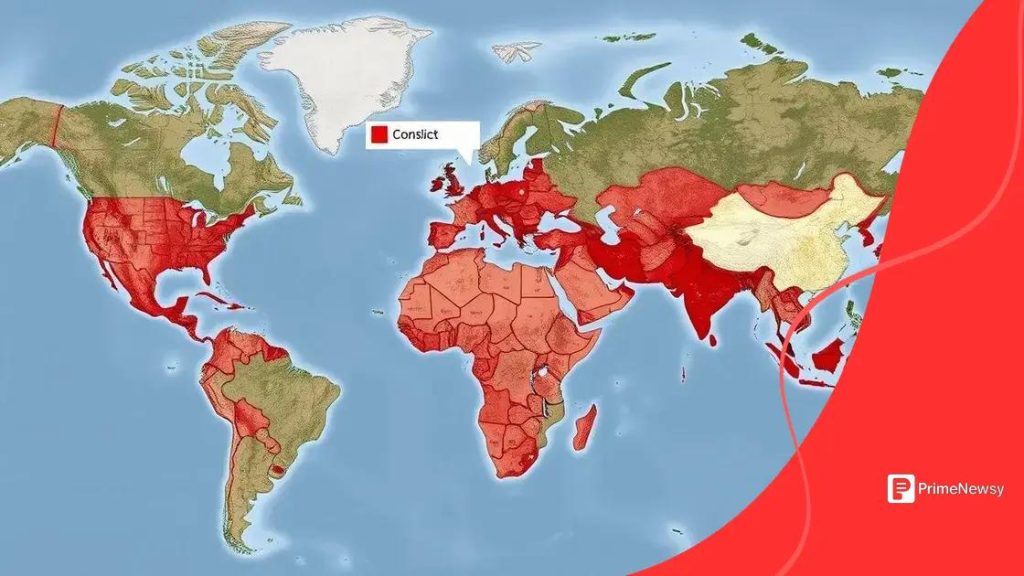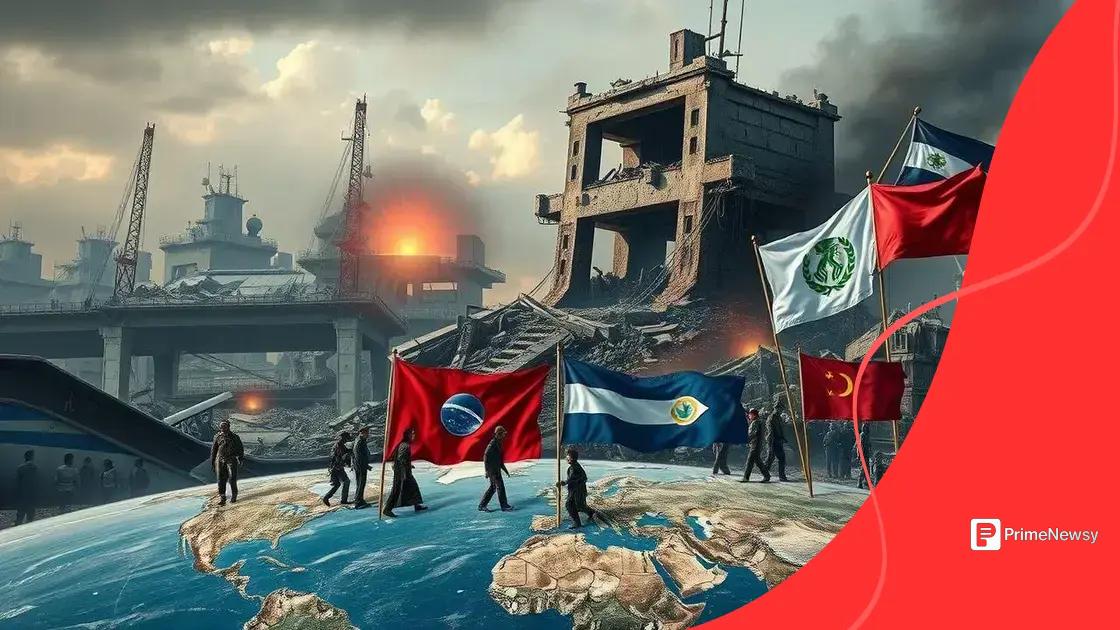Current updates on rising global conflicts

Anúncios
Current updates on rising global conflicts reveal ongoing tensions in regions like Ukraine, the Middle East, and Africa, where humanitarian efforts and international diplomacy are crucial for promoting peace and stability.
Current updates on rising global conflicts are essential for understanding today’s shifting geopolitical landscape. These conflicts affect not just the regions involved, but also trigger global repercussions. Curious about how these situations evolve and impact us all? Let’s take a closer look.
Anúncios
Overview of key global conflicts
Understanding the overview of key global conflicts today is essential for grasping the complexities that shape our world. Current tensions span various regions, causing political, social, and economic repercussions globally. Knowing the main conflicts can help us analyze their implications and respond accordingly.
Major Conflicts in Today’s World
Several regions are currently experiencing significant strife. Among them, the following conflicts stand out:
- Ukraine and Russia: This ongoing conflict has drastically reshaped European security dynamics, leading to widespread humanitarian crises and global economic impact.
- Middle East Tensions: Long-standing disputes involving Israel and Palestine continue to escalate, affecting millions and prompting international discourse.
- Myanmar’s Civil Unrest: Following the military coup, the situation in Myanmar has devolved into a humanitarian disaster amid widespread protests and violence.
- Ethiopia’s Tigray Conflict: This conflict has resulted in significant human suffering and political instability, drawing concern from various international communities.
Each of these conflicts, while unique, shares common threads such as historical grievances, ethnic tensions, and issues of governance. Furthermore, they often evoke deep-seated emotions and complicated narratives that require careful consideration. Understanding these conflicts means delving into their origins and motivations.
Anúncios
Underlying Causes of Global Conflicts
The roots of today’s conflicts can often be traced back to factors like colonial histories, economic disparities, and cultural clashes. For instance, the colonial legacies left behind borders that do not reflect ethnic realities, leading to tensions. Economic disparities, where wealth is concentrated in specific areas while others remain impoverished, breed discontent and strife.
Moreover, the struggle for resources amplifies tensions, as seen in conflicts over water, minerals, and energy sources. The interplay of these factors creates a complex web that fuels conflict and complicates resolution efforts.
It is also important to recognize the role of social media in current conflicts, as it serves as a powerful tool for information dissemination and mobilization. While it can provide valuable insights, it can also spread misinformation and exacerbate tensions, making the situation even more precarious.
Root causes of modern conflicts
Understanding the root causes of modern conflicts is critical for anyone looking to grasp today’s geopolitical issues. Conflicts often arise from a mix of historical, social, and economic factors that intertwine, creating complex scenarios requiring thoughtful responses.
Historical Grievances
Many modern disputes have origins in historical injustices. Colonialism, for example, drew borders that disregarded cultural and ethnic boundaries. This has led to tensions as different groups vie for power and recognition in newly formed nations.
- Land Disputes: Competing claims to land can lead to conflicts, especially when tied to cultural identities.
- Ethnic Rivalries: Historical tensions between ethnic groups often remain unresolved, fueling animosity.
- Revolutionary Movements: In some regions, historical grievances lead to uprisings against perceived oppression.
Moreover, unresolved historical events, such as genocides or colonizations, can leave legacies that ignite current conflicts, making reconciliation difficult.
Socioeconomic Factors
Economic disparity plays a significant role in modern conflicts. Poverty and lack of access to resources can breed frustration and desperation. These socioeconomic issues can escalate when they coincide with political oppression. When citizens feel marginalized, they are more likely to turn to violence as a means of expressing their discontent.
The struggles for resources such as water, oil, and minerals are central to many conflicts today. Competing interests often create tension between nations or regions, as seen in places like the Middle East and parts of Africa.
Additionally, youth unemployment can lead to instability. Young people, feeling hopeless and disenfranchised, may become susceptible to extremist ideologies. This phenomenon reveals how interconnected socioeconomic factors are with political environments.
Political Instability
Political circumstances often exacerbate existing tensions. In regions where governments are weak or corrupt, the absence of effective governance can lead to civil unrest. When laws are not enforced fairly, or leaders do not represent the people’s interests, frustration can mount, leading to conflict.
Effective governance requires addressing not just immediate concerns but also the underlying issues related to injustice and inequality. Peaceful and democratic processes can help mitigate conflict by allowing individuals and communities to address grievances and seek change through dialogue and collaboration.
Impact on global stability

The impact on global stability due to ongoing conflicts is profound. Conflicts not only reshape the regions where they occur but also have far-reaching implications worldwide. Understanding these impacts is crucial as they can affect everything from global economies to international relations.
Affecting International Relations
Conflicts can strain diplomatic ties between nations. For instance, when countries support opposing sides in a conflict, it can lead to tensions that disrupt established alliances. This creates an atmosphere of uncertainty on the global stage.
- Sanctions and Trade Restrictions: Countries may impose sanctions on nations involved in conflicts, which can lead to economic downturns.
- Increased Military Spending: Nations may divert resources to military operations, impacting social programs.
- Refugee Crises: Conflicts often lead to mass displacement, creating refugee crises that challenge neighboring countries and international organizations.
The ripple effects of such developments can destabilize entire regions, leading to further conflicts. As alliances shift and countries are drawn into disputes, the landscape of international relations becomes more fragile and complex.
Economic Consequences
The economic impact of conflicts can be devastating. Disruptions in trade routes, damage to infrastructure, and loss of human capital severely hinder economic growth. Countries directly involved in conflicts often see significant drops in foreign investment as businesses seek safer environments.
Moreover, natural resources become targets. Control over valuable resources can lead to fierce competition, escalating conflicts further. For example, disputes over oil reserves and water rights are common in various conflict zones and severely impact global markets.
Social Implications
Socially, conflicts lead to a breakdown of trust among communities. When people experience violence and loss, it creates deep scars that can last for generations. This erosion of social cohesion can make reconciliation efforts incredibly challenging, perpetuating cycles of violence.
Education and healthcare systems often suffer during conflicts, limiting economic opportunities and leaving lasting impacts on future generations. The psychological toll on affected populations can lead to widespread trauma, further destabilizing affected regions.
Recent developments in conflict zones
The recent developments in conflict zones have captured global attention as tensions continue to rise. Understanding these developments is crucial because they affect not only the nations involved, but also global politics and security.
Current Hotspots
Several areas around the world are experiencing significant changes. In Ukraine, the conflict has escalated, drawing widespread condemnation and new sanctions from multiple countries. The situation remains fluid, with ongoing battles that reshape the landscape daily.
- Ukraine: The war has seen recent shifts in control of territory, with both sides trying to outmaneuver each other.
- Middle East: In places like Syria, new alliances are forming as regional powers adjust their strategies amid changing circumstances.
- Africa: Conflicts in Ethiopia and the Democratic Republic of Congo continue to evolve, often overlooked but critical in global discussions.
These developments illustrate how quickly situations can change, creating new challenges for peacekeeping efforts and humanitarian relief.
International Response
The international community’s response to these conflicts has varied significantly. Ongoing diplomatic negotiations aim to find sustainable solutions to intense conflicts. Countries are engaging in different types of discussions, often leading to peace talks or ceasefires.
However, humanitarian organizations struggle to deliver aid effectively due to security concerns and restrictions imposed by warring parties. This situation highlights the dire need for cooperation among nations to ensure aid reaches those in need.
Humanitarian Impact
Recent developments also come at a high human cost. The civilian population in conflict zones faces increasing challenges, including displacement, food insecurity, and a lack of medical care. Refugee camps are overflowing as families flee violence, seeking safety and stability.
Organizations like the United Nations are working tirelessly to document human rights abuses and provide support where possible. It is essential for international actors to recognize and respond to the growing humanitarian crisis caused by these ongoing conflicts.
What the international community is doing
The international community plays a crucial role in addressing and mitigating the impacts of global conflicts. Various organizations, governments, and coalitions are taking steps to promote peace and stability in affected regions. Understanding these efforts helps highlight the collective responsibility of nations to foster a more peaceful world.
Diplomatic Initiatives
One of the primary ways the international community responds to conflicts is through diplomacy. Countries often engage in negotiations to resolve disputes and establish ceasefires. For instance, peace talks facilitated by organizations like the United Nations aim to bring conflicting parties to the negotiation table.
- Peacekeeping Missions: The UN deploys peacekeeping forces to areas in turmoil to maintain order and protect civilians.
- Mediation Efforts: Neutral countries may act as mediators, helping to bridge gaps between conflicting parties.
- Sanctions and Incentives: Nations may impose sanctions to pressure countries into compliance, while offering incentives for cooperation.
Such diplomatic measures are essential to reducing tensions and fostering dialogue. While success is not guaranteed, consistent international pressure can lead to meaningful discussions.
Humanitarian Aid
In addition to diplomatic efforts, the international community provides humanitarian assistance to those affected by conflicts. Organizations like the Red Cross and various non-profits work tirelessly to deliver food, medical care, and shelter to displaced people.
Humanitarian efforts focus on:
- Emergency Relief: Quick response teams are deployed to deliver essential supplies in crisis situations.
- Long-term Support: Assistance is provided not just during conflicts but also in recovery phases, helping communities rebuild.
- Health Services: Medical teams offer care for injuries and diseases prevalent in conflict zones.
This support is vital in alleviating the suffering of those caught in conflict, emphasizing the moral obligation of the international community.
Advocacy and Education
Furthermore, advocacy groups raise awareness about the impacts of global conflicts. By educating the public and policymakers, they create pressure for action and generate support for humanitarian initiatives. Social media campaigns and public demonstrations highlight the plight of affected populations, inspiring global mobilization.
Educational programs focused on conflict resolution and peacebuilding aim to teach future generations the importance of dialogue and understanding. These initiatives are crucial for cultivating a culture of peace and resilience against future conflicts.
FAQ – Frequently Asked Questions about Global Conflicts
What are the primary causes of modern global conflicts?
The primary causes include historical grievances, socioeconomic disparities, and political instability that can lead to unrest.
How is the international community responding to rising conflicts?
The international community engages in diplomatic efforts, provides humanitarian aid, and advocates for peace through various initiatives.
What role do humanitarian organizations play in conflict zones?
Humanitarian organizations deliver essential supplies, provide medical care, and support displaced individuals affected by conflicts.
Why is it important to understand recent developments in conflict zones?
Understanding these developments helps inform global responses, supports effective policy-making, and raises awareness about the human impact of conflicts.